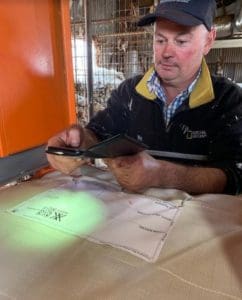
NSW wool classer Doug Mortimer scans an eBale QR code into WoolClip with his mobile phone.
AN integrated and effective wool traceability system should be created in Australia as soon as it is feasible, a new report has recommended.
The report released by peak grower body WoolProducers Australia – ‘Traceability in the Australian wool and sheep industry’ – has made several priority recommendations to meet biosecurity and provenance requirements.
The report’s priority recommendations include:
– requiring a valid Property Identification Code and a National Wool Declaration accompany all wool consignments from farm to point of export;
– fast-tracking the roll-out of AWEX individual identification for use on all wool packs within two years, and linking this with PIC and NWD details for recording on a central database;
– fast-tracking the industry’s EDI update project “to increase compatibility with other systems as a matter of urgency”;
– phasing out the paper NWD and classer specifications within five years, and separating the NWD from the speci;
– requiring clear identification of sellers of privately-sold wool in all states;
– establishing an electronic source and handling date identification system for bulk-classed and interlot wool lots and bales;
– requiring all points of wool aggregation in the supply chain to have a PIC, and;
– requiring all PIC, NWD and classer specification details be recorded on a central database.
Recognising that several elements of a wool traceability system are already in place or under development, WoolProducers general manager Adam Dawes said the WPA would meet with the industry’s main service providers – The Australian Wool Exchange, the AWTA and Australian Wool Innovation – later this week to work on implementing the report’s recommendations.
“I think it is incumbent on the wider wool industry to come together and work out and discuss a collective response to the recommendation to the report,” he said.
He said one of the recommendations was to establish an equitable cost-sharing agreement between the government and industry to implement the necessary changes and have ongoing sustainable funding of an enhanced system.
The report also recommended the development of:
- an industry data governance framework and ‘terms of use’,
- a comprehensive implementation plan using the principles of shared responsibility, mutual and whole of industry benefit, and;
- government analysis of the regulatory impact of implementing the PIC, NWD, private wool sales identification and wool aggregation PIC recommendations.
Mr Dawes said an assessment of the mainly mob and visual ear tag-based National Livestock Identification System for sheep was outside the scope of the project.
“What we found is that because of the particularly post farmgate handling practices associated with wool it is possible, but not practical, to track individual sheep within a lot of wool.
“The report talks about tracking wool back to the property of origin or the PIC of origin and through that if deemed necessary, we can track it back to the mob of origin or the class of stock of origin through the classer’s speci,” he said.
The report said all stakeholders, from producers through to exporters, research and development corporations, service providers and governments have an obligation to work together in the interests of the industry and protect its role in the national economy.
“It is a shared responsibility to ensure the creation of an integrated and effective traceability system as soon as is feasible, commensurate with the level of exposure to biosecurity risk currently faced by the industry.”
The report was released after an industry-wide briefing conducted by WoolProducers on 13 December, outlining key findings and recommendations. Mr Dawes said.
Mr Dawes said the report makes 14 recommendations, including eight priority recommendations that fall under the four key elements of a traceability system, ie. identification of the source and of the product, a mechanism to record movement of the product and widespread engagement.”
“An additional four recommendations were also made to assist with implementation of the recommendations and further enhance the proposed traceability system,” he said.
During the project, 105 people from 65 organisations were interviewed to ensure that the recommendations were fit for purpose and provide the best chance of industry ownership and support of the proposed recommendations.
“It is important to note that these recommendations are not WoolProducers’ recommendations, they are independent and have been made in the interests of establishing a fit-for-purpose traceability system to meet both the biosecurity and provenance requirements of our industry,” Mr Dawes said.
“WoolProducers are aware that if this is to be a success that all industry organisations, including service providers must make changes to how they are currently doing business to implement this traceability system.
“We will work with all industry bodies to facilitate these changes but make it clear that it is our expectation that these organisations enter these discussions with an open mind,” he said.
“The reality is that we as an industry must have an effective traceability system for both commercial and regulatory reasons, if we are not proactive in this space, either government or third-parties, such as quality assurance providers will set the agenda for us which may result in additional costs and a system that is fit for their purpose(s), not ours.”
WoolProducers thanked the report consultants Chris Wilcox, David Marland and Andrew Henderson and all industry participants.
The ‘Traceability in the Australian wool and sheep industry’ project was funded as part of the Federal Government’s Traceability Grants Program, which supports the government’s Modernising Agricultural Trade Agenda.
A copy of the report can be found on the WoolProducers Australia website www.woolproducers.com.au

HAVE YOUR SAY